Home / E and Z Notation For Alkenes (+ Cis/Trans)
Alkene Reactions
E and Z Notation For Alkenes (+ Cis/Trans)
Last updated: March 20th, 2024 |
E and Z Notation For Alkenes
- Unlike C–C single bonds, C–C double bonds can’t undergo rotation without breaking the pi bond
- One consequence of this is geometric isomerism – the existence of alkene stereoisomers that differ solely in how their substituents are arranged in space about the double bond
- In simple cases where there are two identical substituents on each carbon of the alkene, we can use cis– and trans– to designate the isomers where those substituents are on the same and opposite sides of the double bond, respectively.
- For geometric isomers that lack two identical substituents, we rank the two substituents on each end of the double bond according to the Cahn-Ingold-Prelog (CIP) rules.
- The Z isomer (“zusammen“, same) is the geometric isomer where the #1 ranked substituents are on the same side of the double bond. Mnemonic: “zee zame zide“
- E isomer (“entgegen“) is the geometric isomer where the #1 ranked substituents are on the opposite side of the double bond,
Table of Contents
- When do we use cis– and trans– Notation In Rings?
- cis– and trans– Isomerism In Alkenes
- Watch out for ambiguous names when geometrical isomerism is possible!
- cis– and trans– isomerism in cyclic alkenes
- When “cis“- and “trans‘” fails: E and Z Notation
- E and Z Notation For Alkenes
- Breaking Ties: The Method of Dots
- Conclusion: E and Z Notation For Alkenes
- Notes
- Quiz Yourself!
This post was co-authored with Matt Pierce of Organic Chemistry Solutions. Ask Matt about scheduling an online tutoring session here.
Quick Review: cis– And trans- Isomerism (“Geometrical Isomerism”) In Rings
Earlier on our MOC series on cycloalkanes, we saw that a key feature of small rings is that they can’t be turned “inside out” without breaking bonds.(See post: Cycloalkanes – Dashes and Wedges)
One of the most important consequence of this is that it can lead to the existence of stereoisomers – molecules which share the same molecular formula and the same connectivity but have a different arrangement of atoms in space.
These two versions of 1,2 dichlorocyclopentane (below) are an example. They have the same connectivity – both are 1,2-dichlorocyclopentane – but have different arrangements of their atoms in space. The chlorines are on the same side of the ring in the left-hand isomer (both “wedges”, coming out of the page) and on the opposite sides (one wedged, one dashed) on the right-hand isomer.
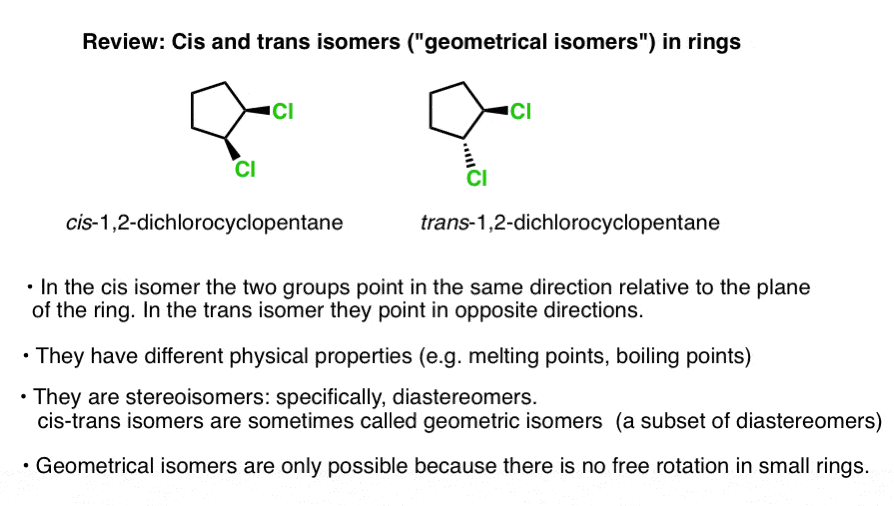
These two molecules cannot be interconverted through rotation of the C-C bond without rupturing the ring (use a model kit and try, if you like). They are therefore isomers.
Molecules which have the same connectivity but different arrangement in space are known as stereoisomers.
Specifically, the relationship between the two molecules above is that of diastereomers: stereoisomers which are not mirror images of each other. (See post: Types of Isomers)
These two molecules have different physical properties – different boiling points, melting points, reactivities, spectral characteristics and so on.
[Just to note, the other subclass of stereoisomer is “enantiomers”. We apply this to two stereoisomers which are (non-superimposable) mirror images of each other. Also: keep in mind that the terms “diastereomer” and “enantiomer” denote comparative relationships, like the terms “brother” or “cousin”. ]
1. When Do We Use cis- And trans- Notation In Rings?
We use the terms cis- and trans– to denote the relative configuration of two groups to each other in situations where there is restricted rotation.
[Side note: the “restricted rotation” is how cis- and trans- subtly differs from syn and anti, which we use in cases where there is free rotation, such as the orientation of methyl groups in “eclipsed” and “staggered” butane. Bottom line: syn and anti forms can generally be interconverted through bond rotation: cis and trans forms cannot. ]
In nomenclature, “cis” is used to distinguish the isomer where two identical groups (e.g. the two chlorines in 1,2-dichlorocyclopentane) are pointing in the same direction from the plane of the ring, and trans to distinguish the isomer where they point in opposite directions. [You might also hear organic chemists say, “the chlorines are cis to each other” or “the hydrogens are trans to one another”.]
A common name for these so-called “cis-trans” isomers is “geometric isomers”. Those scolds at IUPAC actually discourage the term “geometric isomers”, and for once, I agree: the term is somewhat redundant and can cause confusion. In the rest of this post I’ll just use the term “cis-trans” isomers.
In order for cis- trans- isomerism to exist in rings, we need two conditions:
- two (and only two) carbons each bearing non-identical substituents above and below the ring
- the two carbons have at least one of those substituents in common
In 1,2-dichlorocyclopentane we saw that C-1 and C-2 each had non-identical substituents (H and Cl) above and below the ring, and they each had at least one substituent in common (in fact they have two substituents in common: H and Cl ).
Here’s another example: cis- and trans– 1-ethyl-2-methylcyclobutane. Note that they each have two carbons which each bear non-identical substituents above and below the ring (H and CH3; H and CH2CH3). They also have at least one substituent in common (H). So we can refer to cis-1-ethyl-2-methylcyclohexane as the isomer where the two hydrogens are pointing in the same direction, and trans where they point in opposite directions.
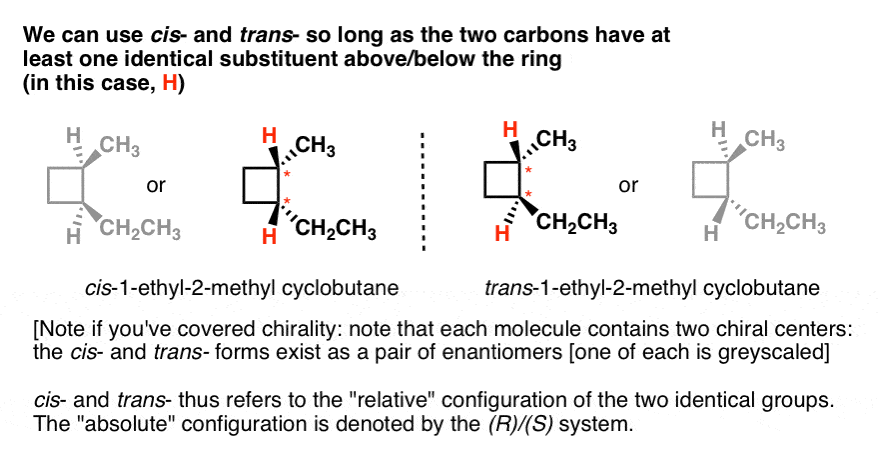
If you’ve covered chirality, you might also note an interesting fact: there are two ways to draw each of the cis- and trans– isomers, and they can’t be superimposed on each other. These are enantiomers, by the way. (See post: Enantiomers, Diastereomers or the Same)
So cis- and trans- doesn’t specify which enantiomer (it can be applied to either). It’s just describing the relative configuration of the two groups (H in this case). If we want to specify a particular enantiomer, we need to use the Cahn-Ingold-Prelog (CIP) system of assigning R and S configurations, which provides us with the “absolute” configuration. In that case, cis– and trans- is redundant. (See post: Cahn-Ingold-Prelog System)
Because cis– and trans– is relative, it doesn’t work if the two carbons don’t share a common substituent. In that case you also have to use (R)/(S) .
We’re taking too long to go through rings here, so let’s just illustrate 2 examples where “cis” and trans” doesn’t work in rings and leave it there.
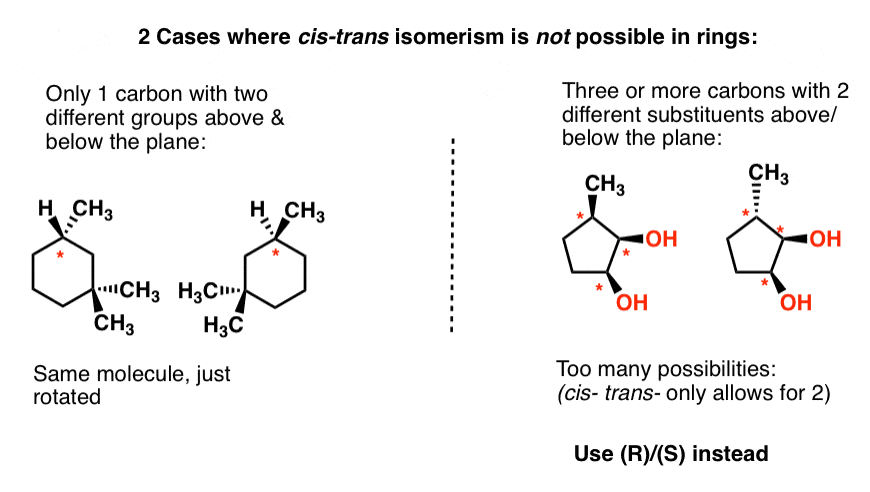
2. cis– and trans- Isomerism (Geometric Isomerism) In Alkenes
cis-trans isomerism is also possible for alkenes. As in small rings, rotation about pi bonds is also constrained: due to the “side-on” overlap of pi bonds, one can’t rotate a pi bond without breaking it. This stands in contrast to conventional sigma bonds (single bonds) in acyclic molecules, where free rotation is possible: witness 1,2-dichloroethane (below left).
Hence we can have molecules such as cis-1,2-dichloroethene [boiling point 60°C] and trans-1,2-dichloroethene [boiling point: 48°C] which can be separated from each other due to their differing physical properties.
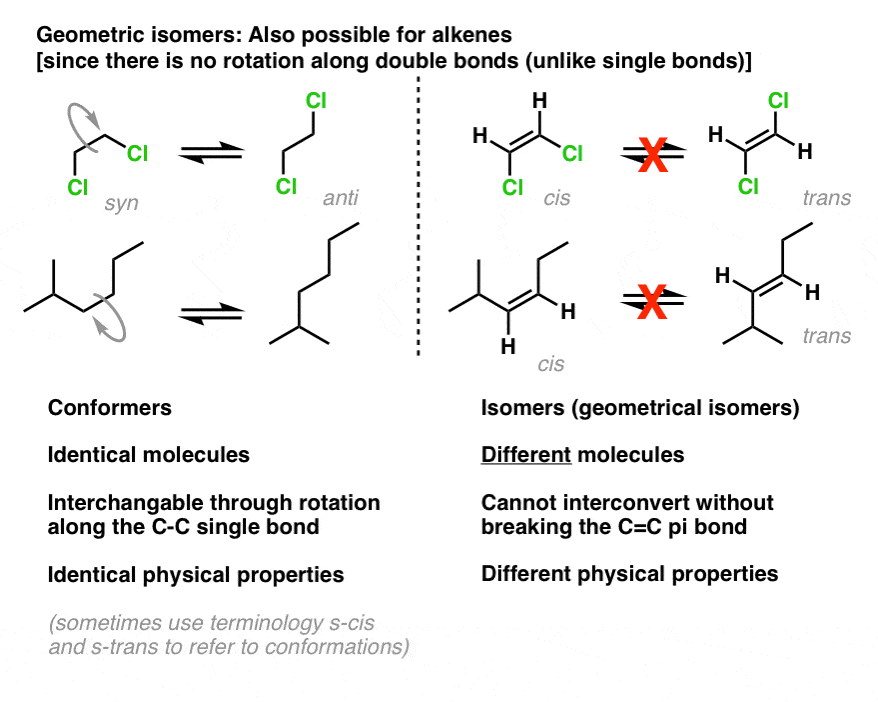
We can also use the cis–trans nomenclature to distinguish isomers such as 2-methyl-3-hexene (above right). In the cis isomer, the two hydrogens are on the same side of the pi bond, and in the trans isomer, the two hydrogens are on the opposite side of the bond. [Note: this risks a “tsk-tsk” with accompanying finger-wag from IUPAC , but it nevertheless gets the right structure: see the Note 1 below for a digression as to why]
As with rings, the minimum requirement for cis-trans isomerism in alkenes is that each carbon is bonded to two different groups, and that the two carbons have at least one substituent in common.
As with rings, cis-trans isomerism isn’t possible if one of the carbons of the double bond is attached to two identical groups, as with 1,1-dibromo-1-propene, below. Try it for yourself if you’re not convinced.
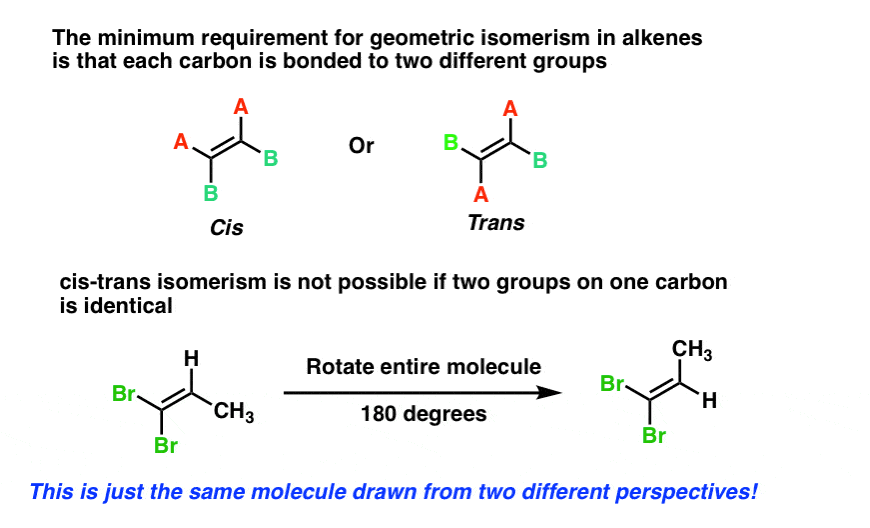
3. Watch Out For Ambiguous Names Where Cis/Trans Isomerism Is Possible
A quick digression: one consequence of our newfound appreciation of geometrical isomerism is that many simple-sounding molecule names are actually ambiguous.
For instance, the descriptor “3-hexene” does not unambiguously describe a specific molecule. [The same is true for 2-butene: try it! ]. To nail down the specific molecule, we need to specify cis– or trans– 3-hexene.
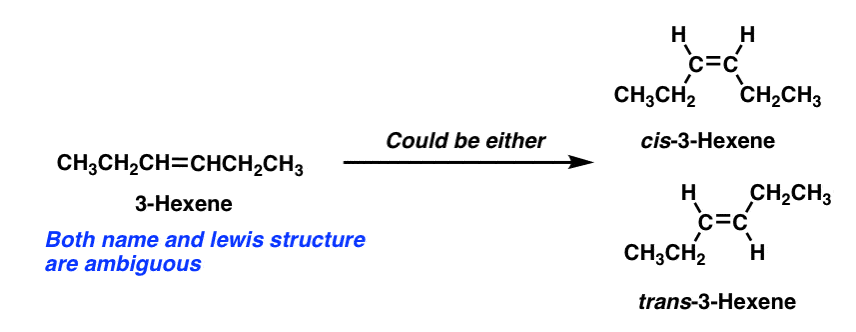
Note that 1-hexene is still OK, since the 1-position of 1-hexene is attached to two identical groups (hydrogens) and thus no cis–trans isomers are possible.
4. Cis– Trans- Isomerism For Cyclic Alkenes
cis- and trans can also be applied to alkenes in rings. For example, on paper it’s possible to draw cis– and trans– cyclohexene, since the pi bond fulfills the requirements for cis- trans- isomerism. In reality, trans-cyclohexene is impossibly strained. Try kissing yourself on the tailbone. That will give you some idea of the strain involved in trying to accommodate a trans– double bond in a six membered ring . [Note 2]
For this reason, for ring sizes 7 and below, it’s safe to ignore writing “cis” : the configuration is assumed.
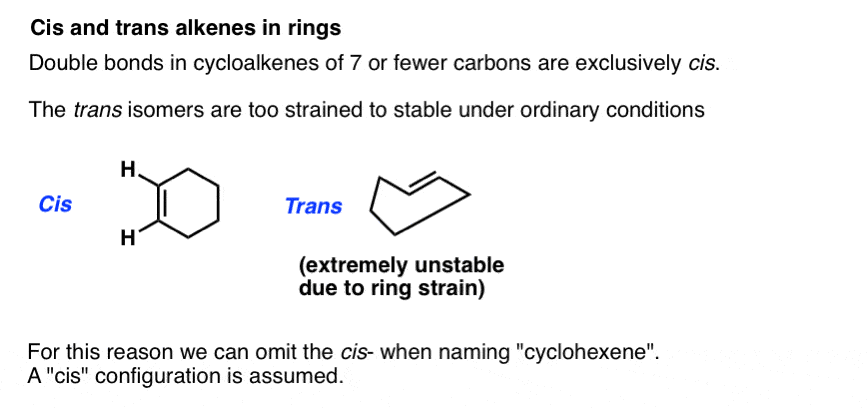
At ring sizes of 8 and above, we do need to put a cis– or trans- in the name, because the trans– isomer becomes feasible. (Imagine trying to kiss yourself on the tailbone if you had the neck of a giraffe: suddenly not impossible!)
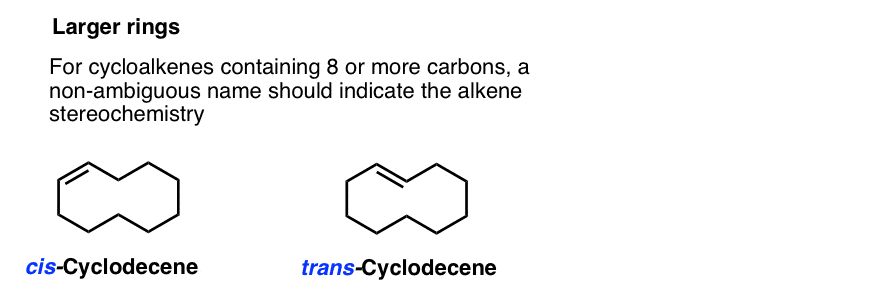
5. A Solution For When “Cis” and “Trans” Fails: The E/Z System
We saw that cis and trans fails in rings when the two carbons lacked a common substituent. It also fails for alkenes under these circumstances.
Case in point: try to apply cis and trans to the alkene below:
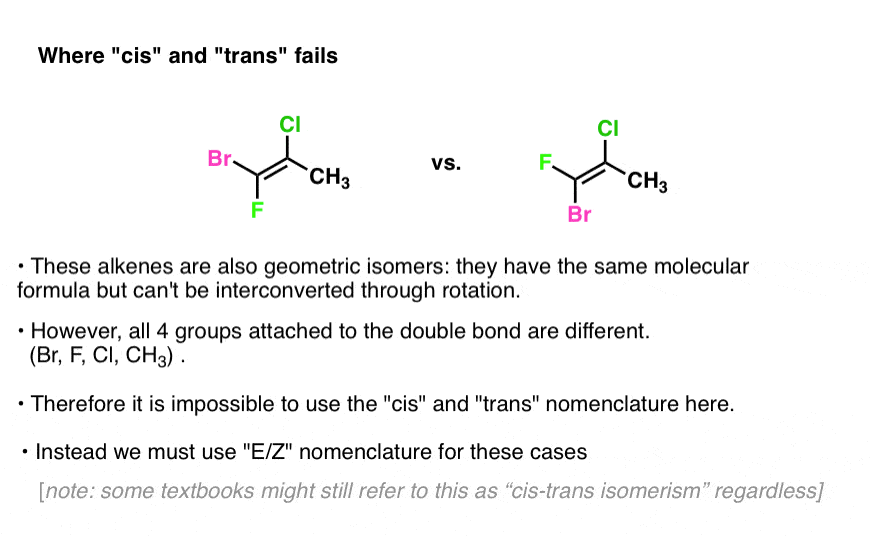
See the problem?
In the absence of two identical groups, we have no reference point!
On the left, the chlorine is cis to Br and trans to F. But does that really justify calling the isomer “cis” ? How do we decide?
What we need is some way to determine priorities in these situations.
[note: some textbooks may still refer to this alkene as exhibiting “cis-trans isomerism” even though we must use E and Z]
6. The E and Z Notation For Alkenes
Thankfully, we can apply the ranking system developed by Cahn, Ingold, and Prelog for chiral centers (as touched on in this earlier post on (R)/(S) nomenclature) for this purpose.
The protocol is as follows:
- Each carbon in the pi bond is attached to two substituents. For each carbon, these two substituents are ranked (1 or 2) according to the atomic numbers of the atom directly attached to the carbon. (e.g. Cl > F )
- If both substituents ranked 1 are on the same side of the pi bond, the bond is given the descriptor Z (short for German Zusammen, which means “together”).
- If both substituents ranked 1 are on the opposite side of the pi bond, the bond is given the descriptor E (short for German Entgegen, which means “opposite”).
So Z resembles “cis” and E resembles “trans” . (Note: they are not necessarily the same and do not always correlate: see Note 2 for an example of a cis alkene which is E . The E/Z system is comprehensive for all alkenes capable of geometric isomerism, including the cis/trans alkene examples above. We often use cis/trans for convenience, but E/Z is the “official”, IUPAC approved way to name alkene stereoisomers].
One easy way to remember Z is to say “Zee Zame Zide” in a German accent. My way of doing it was pretending that the Z stands for “zis”. Whatever works for you.
Here’s a practical example:
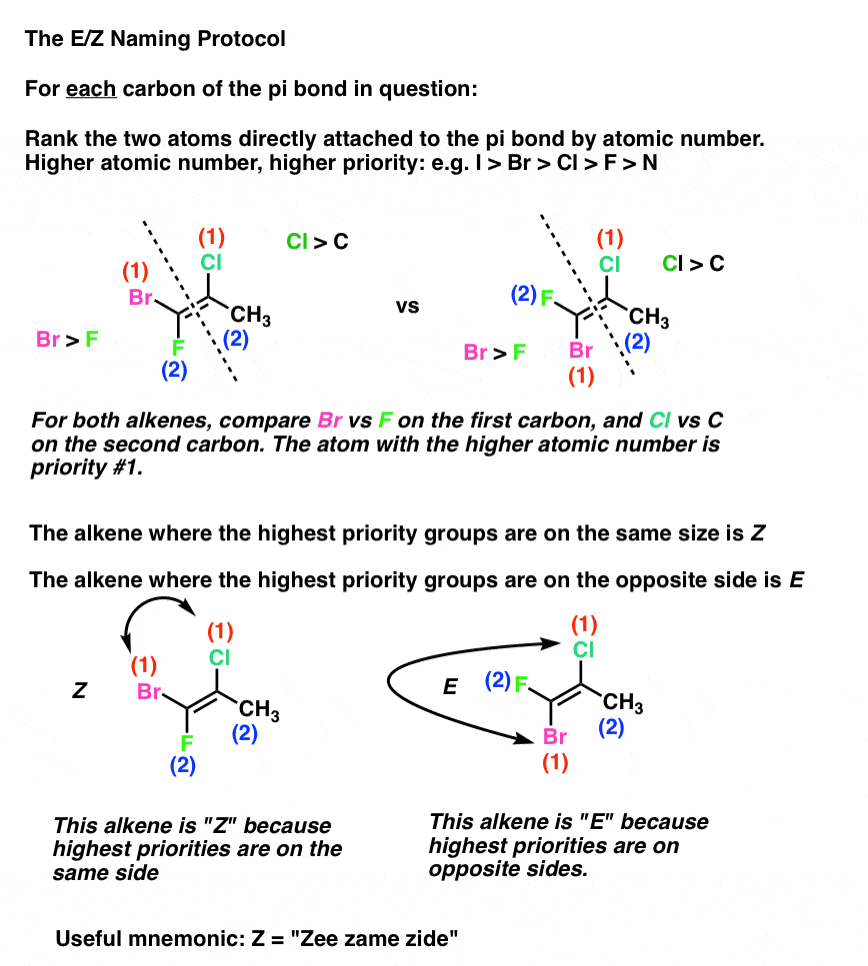
As with chiral centers, ranking according to atomic number can result in ties if we restrict ourselves merely to the atoms directly attached to the pi bonds.
7. Breaking Ties: The Method of Dots
For instance, the alkene below presents us with a dilemma: one of the carbons of the alkene is attached to two carbon atoms. So how do we determine priorities in this case. How do we break ties?
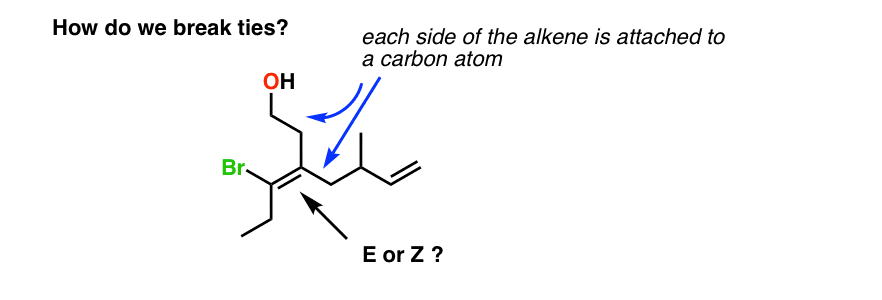
In the case of ties, we must apply the method of dots. Dots are handy placeholders which is why I like to use this method.
- Place a dot on each of the two atoms you are comparing.
- List the 3 atoms each atom is attached to, in order of atomic number.
- Compare the lists, much like you would compare a set of three playing cards. Just as a hand of (8, 8, 7) would beat (8, 7, 7), so would (C, C, H) beat (C, H, H).
- If the lists are identical, move the dots outward to the highest priority atom on the list.
- At the first point of difference, assign (E or Z).
- If there is no difference… then the groups are identical, and E / Z does not apply.
Here’s a practical example of the “method of dots”.
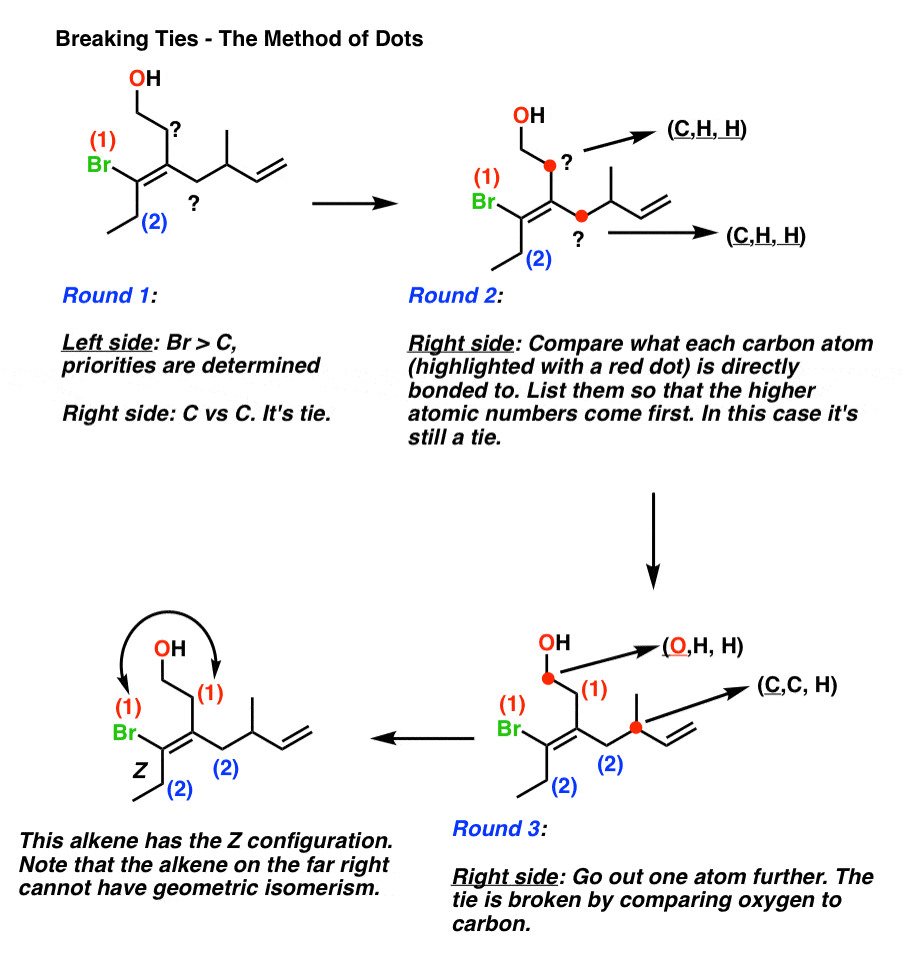
Here’s a more complex example with multiple alkenes. In this case each pi bond is designated by a number with its own separate E or Z configuration.

OK, this was long. But hopefully useful.
Watch out for a future post in which we go into more detail on the “method of dots”.
8. Conclusion: E and Z Notation For Alkenes
cis-trans- is OK for describing simple alkene stereoisomers, but only works in certain cases. Furthermore, it only gives relative configurations. The E/Z system is comprehensive and describes the absolute configuration of the molecule.
See below for an example of an E alkene which is “cis” and a Z alkene which is “trans”.
Just a reminder: this post was co-authored by Matt Pierce of Organic Chemistry Solutions. Ask Matt about scheduling an online tutoring session here.
Notes
Related Articles
- Introduction to Assigning (R) and (S): The Cahn-Ingold-Prelog Rules
- Assigning Cahn-Ingold-Prelog (CIP) Priorities (2) – The Method of Dots
- Alkene Stability
- Types of Isomers: Constitutional Isomers, Stereoisomers, Enantiomers, and Diastereomers
- Enantiomers vs Diastereomers vs The Same? Two Methods For Solving Problems
- Geometric Isomers In Small Rings: Cis And Trans Cycloalkanes
- Stereoselective and Stereospecific Reactions
- Alkene Addition Reactions: “Regioselectivity” and “Stereoselectivity” (Syn/Anti)
Note 1: It’s possible to have an alkene we’d describe as ‘cis’ be E and vice versa.
E/Z is the preferred, more comprehensive nomenclature since it describes absolute configuration, whereas cis- trans- merely describes relative configuration.
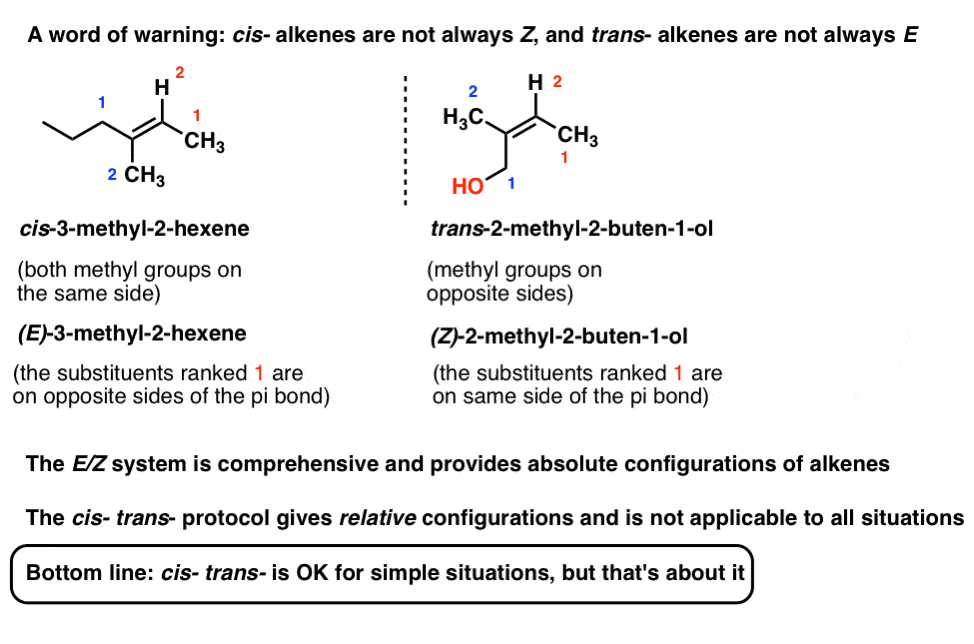
Note 2: trans-cyclopropene, trans-cyclobutene, and trans-cyclopentene have never been synthesized or observed. trans-cyclohexene is a laboratory curiosity, stable at a few degrees above absolute zero. trans-cycloheptene has an extremely short half-life at room temperature. trans-cyclooctene is a stable molecule [it also exhibits axial chirality, which is interesting! ].
Quiz Yourself!
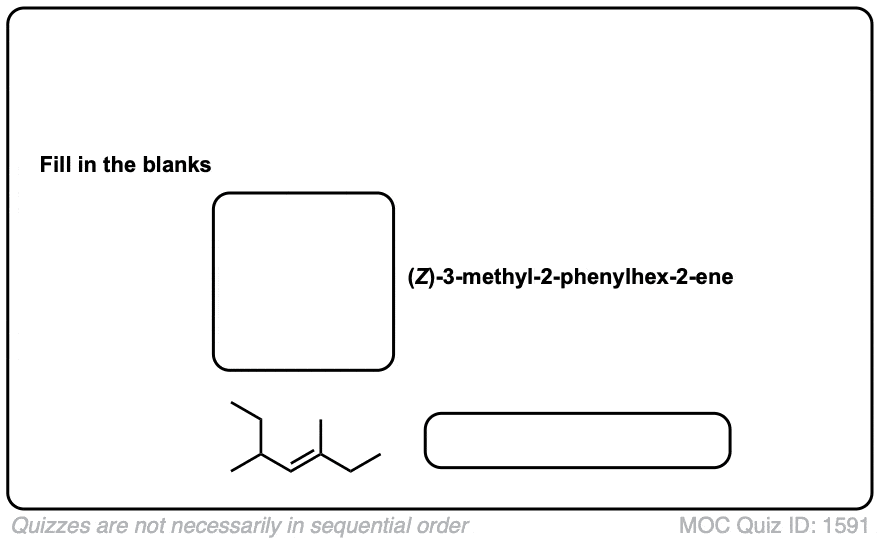 Click to Flip
Click to Flip
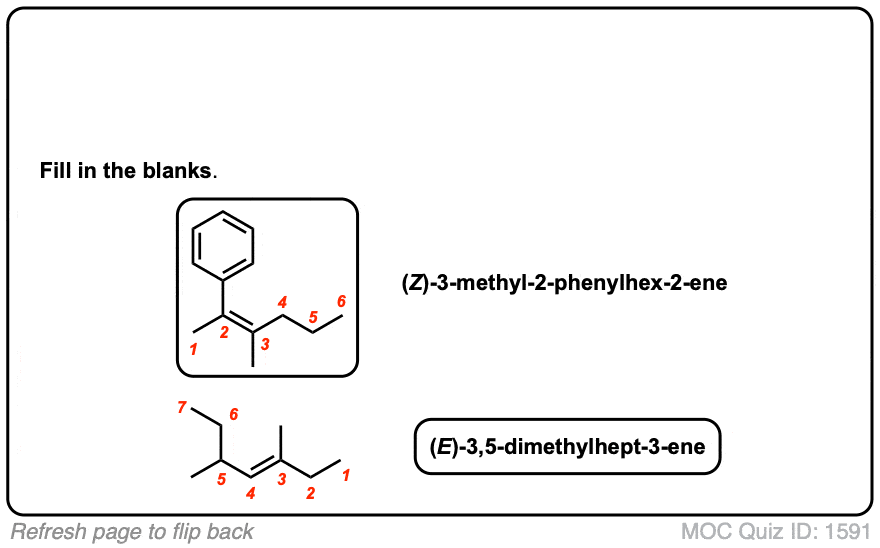
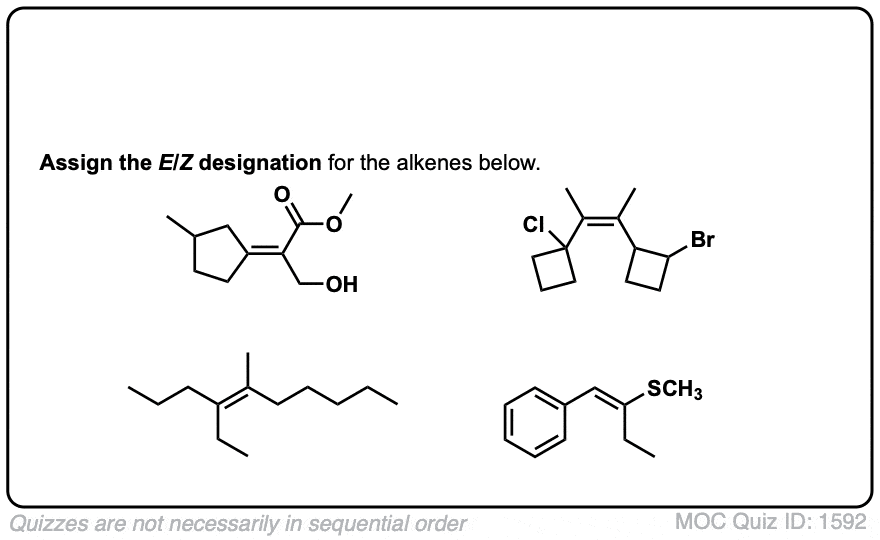 Click to Flip
Click to Flip
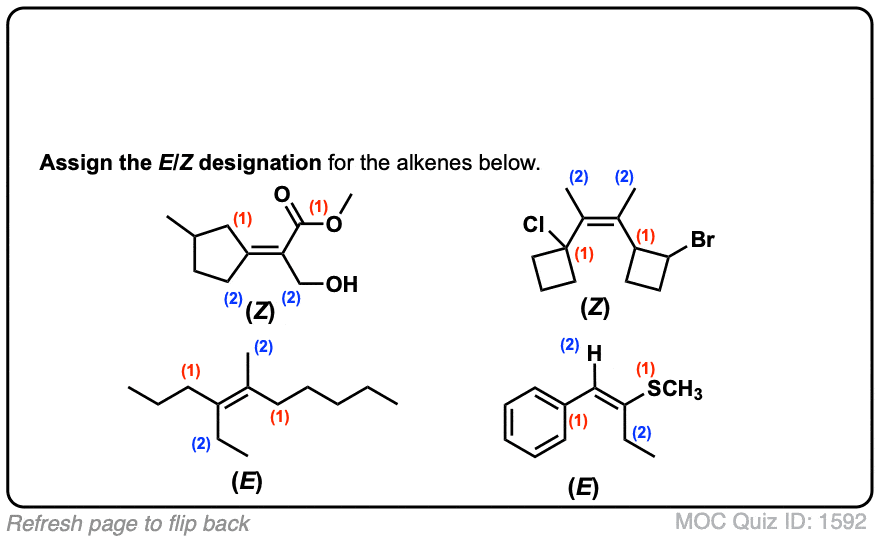
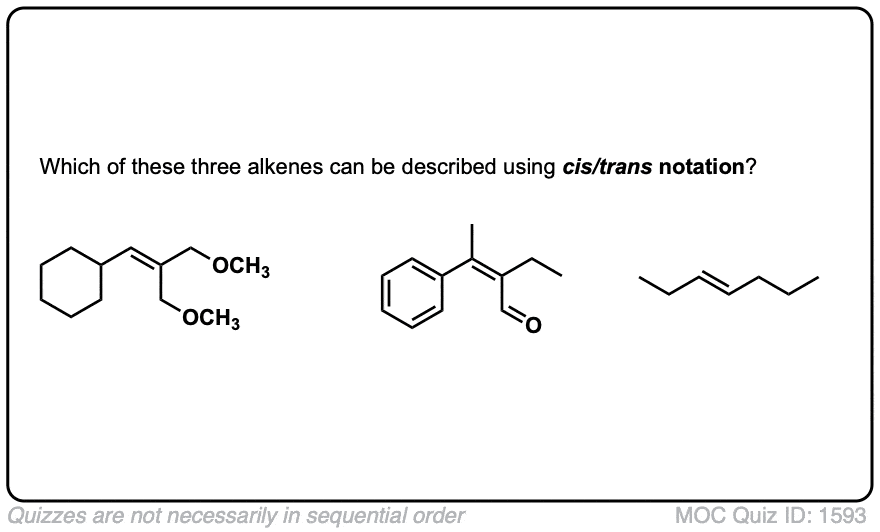 Click to Flip
Click to Flip
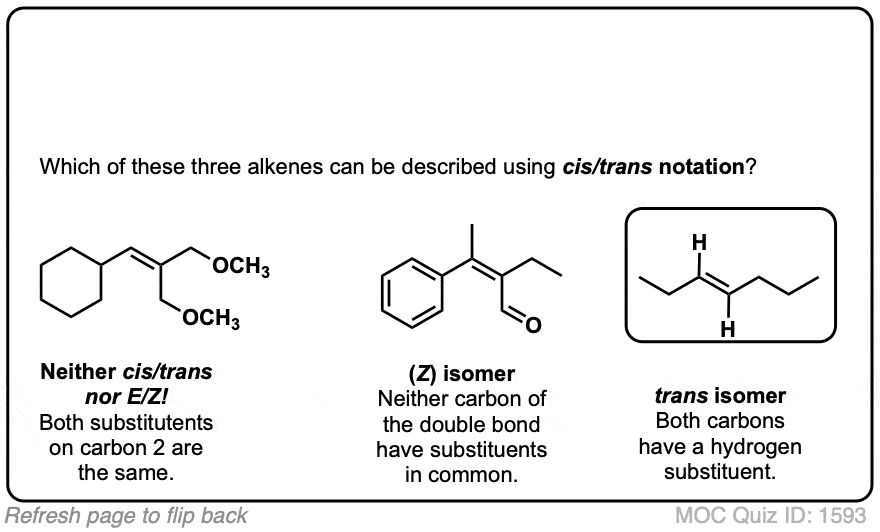
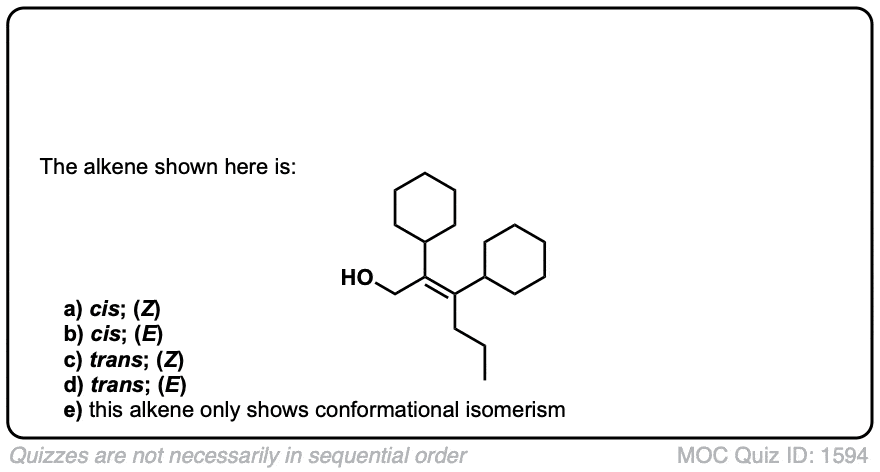 Click to Flip
Click to Flip
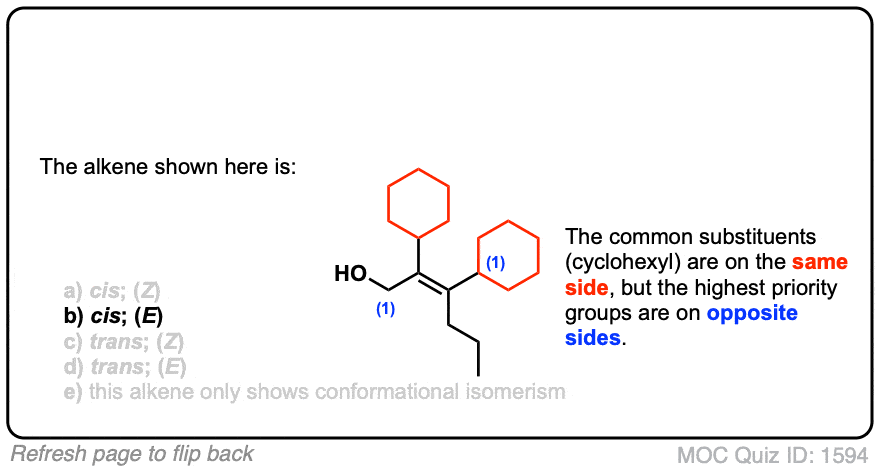
00 General Chemistry Review
01 Bonding, Structure, and Resonance
- How Do We Know Methane (CH4) Is Tetrahedral?
- Hybrid Orbitals and Hybridization
- How To Determine Hybridization: A Shortcut
- Orbital Hybridization And Bond Strengths
- Sigma bonds come in six varieties: Pi bonds come in one
- A Key Skill: How to Calculate Formal Charge
- The Four Intermolecular Forces and How They Affect Boiling Points
- 3 Trends That Affect Boiling Points
- How To Use Electronegativity To Determine Electron Density (and why NOT to trust formal charge)
- Introduction to Resonance
- How To Use Curved Arrows To Interchange Resonance Forms
- Evaluating Resonance Forms (1) - The Rule of Least Charges
- How To Find The Best Resonance Structure By Applying Electronegativity
- Evaluating Resonance Structures With Negative Charges
- Evaluating Resonance Structures With Positive Charge
- Exploring Resonance: Pi-Donation
- Exploring Resonance: Pi-acceptors
- In Summary: Evaluating Resonance Structures
- Drawing Resonance Structures: 3 Common Mistakes To Avoid
- How to apply electronegativity and resonance to understand reactivity
- Bond Hybridization Practice
- Structure and Bonding Practice Quizzes
- Resonance Structures Practice
02 Acid Base Reactions
- Introduction to Acid-Base Reactions
- Acid Base Reactions In Organic Chemistry
- The Stronger The Acid, The Weaker The Conjugate Base
- Walkthrough of Acid-Base Reactions (3) - Acidity Trends
- Five Key Factors That Influence Acidity
- Acid-Base Reactions: Introducing Ka and pKa
- How to Use a pKa Table
- The pKa Table Is Your Friend
- A Handy Rule of Thumb for Acid-Base Reactions
- Acid Base Reactions Are Fast
- pKa Values Span 60 Orders Of Magnitude
- How Protonation and Deprotonation Affect Reactivity
- Acid Base Practice Problems
03 Alkanes and Nomenclature
- Meet the (Most Important) Functional Groups
- Condensed Formulas: Deciphering What the Brackets Mean
- Hidden Hydrogens, Hidden Lone Pairs, Hidden Counterions
- Don't Be Futyl, Learn The Butyls
- Primary, Secondary, Tertiary, Quaternary In Organic Chemistry
- Branching, and Its Affect On Melting and Boiling Points
- The Many, Many Ways of Drawing Butane
- Wedge And Dash Convention For Tetrahedral Carbon
- Common Mistakes in Organic Chemistry: Pentavalent Carbon
- Table of Functional Group Priorities for Nomenclature
- Summary Sheet - Alkane Nomenclature
- Organic Chemistry IUPAC Nomenclature Demystified With A Simple Puzzle Piece Approach
- Boiling Point Quizzes
- Organic Chemistry Nomenclature Quizzes
04 Conformations and Cycloalkanes
- Staggered vs Eclipsed Conformations of Ethane
- Conformational Isomers of Propane
- Newman Projection of Butane (and Gauche Conformation)
- Introduction to Cycloalkanes (1)
- Geometric Isomers In Small Rings: Cis And Trans Cycloalkanes
- Calculation of Ring Strain In Cycloalkanes
- Cycloalkanes - Ring Strain In Cyclopropane And Cyclobutane
- Cyclohexane Conformations
- Cyclohexane Chair Conformation: An Aerial Tour
- How To Draw The Cyclohexane Chair Conformation
- The Cyclohexane Chair Flip
- The Cyclohexane Chair Flip - Energy Diagram
- Substituted Cyclohexanes - Axial vs Equatorial
- Ranking The Bulkiness Of Substituents On Cyclohexanes: "A-Values"
- Cyclohexane Chair Conformation Stability: Which One Is Lower Energy?
- Fused Rings - Cis-Decalin and Trans-Decalin
- Naming Bicyclic Compounds - Fused, Bridged, and Spiro
- Bredt's Rule (And Summary of Cycloalkanes)
- Newman Projection Practice
- Cycloalkanes Practice Problems
05 A Primer On Organic Reactions
- The Most Important Question To Ask When Learning a New Reaction
- Learning New Reactions: How Do The Electrons Move?
- The Third Most Important Question to Ask When Learning A New Reaction
- 7 Factors that stabilize negative charge in organic chemistry
- 7 Factors That Stabilize Positive Charge in Organic Chemistry
- Nucleophiles and Electrophiles
- Curved Arrows (for reactions)
- Curved Arrows (2): Initial Tails and Final Heads
- Nucleophilicity vs. Basicity
- The Three Classes of Nucleophiles
- What Makes A Good Nucleophile?
- What makes a good leaving group?
- 3 Factors That Stabilize Carbocations
- Equilibrium and Energy Relationships
- What's a Transition State?
- Hammond's Postulate
- Learning Organic Chemistry Reactions: A Checklist (PDF)
- Introduction to Free Radical Substitution Reactions
- Introduction to Oxidative Cleavage Reactions
06 Free Radical Reactions
- Bond Dissociation Energies = Homolytic Cleavage
- Free Radical Reactions
- 3 Factors That Stabilize Free Radicals
- What Factors Destabilize Free Radicals?
- Bond Strengths And Radical Stability
- Free Radical Initiation: Why Is "Light" Or "Heat" Required?
- Initiation, Propagation, Termination
- Monochlorination Products Of Propane, Pentane, And Other Alkanes
- Selectivity In Free Radical Reactions
- Selectivity in Free Radical Reactions: Bromination vs. Chlorination
- Halogenation At Tiffany's
- Allylic Bromination
- Bonus Topic: Allylic Rearrangements
- In Summary: Free Radicals
- Synthesis (2) - Reactions of Alkanes
- Free Radicals Practice Quizzes
07 Stereochemistry and Chirality
- Types of Isomers: Constitutional Isomers, Stereoisomers, Enantiomers, and Diastereomers
- How To Draw The Enantiomer Of A Chiral Molecule
- How To Draw A Bond Rotation
- Introduction to Assigning (R) and (S): The Cahn-Ingold-Prelog Rules
- Assigning Cahn-Ingold-Prelog (CIP) Priorities (2) - The Method of Dots
- Enantiomers vs Diastereomers vs The Same? Two Methods For Solving Problems
- Assigning R/S To Newman Projections (And Converting Newman To Line Diagrams)
- How To Determine R and S Configurations On A Fischer Projection
- The Meso Trap
- Optical Rotation, Optical Activity, and Specific Rotation
- Optical Purity and Enantiomeric Excess
- What's a Racemic Mixture?
- Chiral Allenes And Chiral Axes
- Stereochemistry Practice Problems and Quizzes
08 Substitution Reactions
- Introduction to Nucleophilic Substitution Reactions
- Walkthrough of Substitution Reactions (1) - Introduction
- Two Types of Nucleophilic Substitution Reactions
- The SN2 Mechanism
- Why the SN2 Reaction Is Powerful
- The SN1 Mechanism
- The Conjugate Acid Is A Better Leaving Group
- Comparing the SN1 and SN2 Reactions
- Polar Protic? Polar Aprotic? Nonpolar? All About Solvents
- Steric Hindrance is Like a Fat Goalie
- Common Blind Spot: Intramolecular Reactions
- The Conjugate Base is Always a Stronger Nucleophile
- Substitution Practice - SN1
- Substitution Practice - SN2
09 Elimination Reactions
- Elimination Reactions (1): Introduction And The Key Pattern
- Elimination Reactions (2): The Zaitsev Rule
- Elimination Reactions Are Favored By Heat
- Two Elimination Reaction Patterns
- The E1 Reaction
- The E2 Mechanism
- E1 vs E2: Comparing the E1 and E2 Reactions
- Antiperiplanar Relationships: The E2 Reaction and Cyclohexane Rings
- Bulky Bases in Elimination Reactions
- Comparing the E1 vs SN1 Reactions
- Elimination (E1) Reactions With Rearrangements
- E1cB - Elimination (Unimolecular) Conjugate Base
- Elimination (E1) Practice Problems And Solutions
- Elimination (E2) Practice Problems and Solutions
10 Rearrangements
11 SN1/SN2/E1/E2 Decision
- Identifying Where Substitution and Elimination Reactions Happen
- Deciding SN1/SN2/E1/E2 (1) - The Substrate
- Deciding SN1/SN2/E1/E2 (2) - The Nucleophile/Base
- SN1 vs E1 and SN2 vs E2 : The Temperature
- Deciding SN1/SN2/E1/E2 - The Solvent
- Wrapup: The Key Factors For Determining SN1/SN2/E1/E2
- Alkyl Halide Reaction Map And Summary
- SN1 SN2 E1 E2 Practice Problems
12 Alkene Reactions
- E and Z Notation For Alkenes (+ Cis/Trans)
- Alkene Stability
- Alkene Addition Reactions: "Regioselectivity" and "Stereoselectivity" (Syn/Anti)
- Stereoselective and Stereospecific Reactions
- Hydrohalogenation of Alkenes and Markovnikov's Rule
- Hydration of Alkenes With Aqueous Acid
- Rearrangements in Alkene Addition Reactions
- Halogenation of Alkenes and Halohydrin Formation
- Oxymercuration Demercuration of Alkenes
- Hydroboration Oxidation of Alkenes
- m-CPBA (meta-chloroperoxybenzoic acid)
- OsO4 (Osmium Tetroxide) for Dihydroxylation of Alkenes
- Palladium on Carbon (Pd/C) for Catalytic Hydrogenation of Alkenes
- Cyclopropanation of Alkenes
- A Fourth Alkene Addition Pattern - Free Radical Addition
- Alkene Reactions: Ozonolysis
- Summary: Three Key Families Of Alkene Reaction Mechanisms
- Synthesis (4) - Alkene Reaction Map, Including Alkyl Halide Reactions
- Alkene Reactions Practice Problems
13 Alkyne Reactions
- Acetylides from Alkynes, And Substitution Reactions of Acetylides
- Partial Reduction of Alkynes With Lindlar's Catalyst
- Partial Reduction of Alkynes With Na/NH3 To Obtain Trans Alkenes
- Alkyne Hydroboration With "R2BH"
- Hydration and Oxymercuration of Alkynes
- Hydrohalogenation of Alkynes
- Alkyne Halogenation: Bromination, Chlorination, and Iodination of Alkynes
- Alkyne Reactions - The "Concerted" Pathway
- Alkenes To Alkynes Via Halogenation And Elimination Reactions
- Alkynes Are A Blank Canvas
- Synthesis (5) - Reactions of Alkynes
- Alkyne Reactions Practice Problems With Answers
14 Alcohols, Epoxides and Ethers
- Alcohols - Nomenclature and Properties
- Alcohols Can Act As Acids Or Bases (And Why It Matters)
- Alcohols - Acidity and Basicity
- The Williamson Ether Synthesis
- Ethers From Alkenes, Tertiary Alkyl Halides and Alkoxymercuration
- Alcohols To Ethers via Acid Catalysis
- Cleavage Of Ethers With Acid
- Epoxides - The Outlier Of The Ether Family
- Opening of Epoxides With Acid
- Epoxide Ring Opening With Base
- Making Alkyl Halides From Alcohols
- Tosylates And Mesylates
- PBr3 and SOCl2
- Elimination Reactions of Alcohols
- Elimination of Alcohols To Alkenes With POCl3
- Alcohol Oxidation: "Strong" and "Weak" Oxidants
- Demystifying The Mechanisms of Alcohol Oxidations
- Protecting Groups For Alcohols
- Thiols And Thioethers
- Calculating the oxidation state of a carbon
- Oxidation and Reduction in Organic Chemistry
- Oxidation Ladders
- SOCl2 Mechanism For Alcohols To Alkyl Halides: SN2 versus SNi
- Alcohol Reactions Roadmap (PDF)
- Alcohol Reaction Practice Problems
- Epoxide Reaction Quizzes
- Oxidation and Reduction Practice Quizzes
15 Organometallics
- What's An Organometallic?
- Formation of Grignard and Organolithium Reagents
- Organometallics Are Strong Bases
- Reactions of Grignard Reagents
- Protecting Groups In Grignard Reactions
- Synthesis Problems Involving Grignard Reagents
- Grignard Reactions And Synthesis (2)
- Organocuprates (Gilman Reagents): How They're Made
- Gilman Reagents (Organocuprates): What They're Used For
- The Heck, Suzuki, and Olefin Metathesis Reactions (And Why They Don't Belong In Most Introductory Organic Chemistry Courses)
- Reaction Map: Reactions of Organometallics
- Grignard Practice Problems
16 Spectroscopy
- Degrees of Unsaturation (or IHD, Index of Hydrogen Deficiency)
- Conjugation And Color (+ How Bleach Works)
- Introduction To UV-Vis Spectroscopy
- UV-Vis Spectroscopy: Absorbance of Carbonyls
- UV-Vis Spectroscopy: Practice Questions
- Bond Vibrations, Infrared Spectroscopy, and the "Ball and Spring" Model
- Infrared Spectroscopy: A Quick Primer On Interpreting Spectra
- IR Spectroscopy: 4 Practice Problems
- 1H NMR: How Many Signals?
- Homotopic, Enantiotopic, Diastereotopic
- Diastereotopic Protons in 1H NMR Spectroscopy: Examples
- C13 NMR - How Many Signals
- Liquid Gold: Pheromones In Doe Urine
- Natural Product Isolation (1) - Extraction
- Natural Product Isolation (2) - Purification Techniques, An Overview
- Structure Determination Case Study: Deer Tarsal Gland Pheromone
17 Dienes and MO Theory
- What To Expect In Organic Chemistry 2
- Are these molecules conjugated?
- Conjugation And Resonance In Organic Chemistry
- Bonding And Antibonding Pi Orbitals
- Molecular Orbitals of The Allyl Cation, Allyl Radical, and Allyl Anion
- Pi Molecular Orbitals of Butadiene
- Reactions of Dienes: 1,2 and 1,4 Addition
- Thermodynamic and Kinetic Products
- More On 1,2 and 1,4 Additions To Dienes
- s-cis and s-trans
- The Diels-Alder Reaction
- Cyclic Dienes and Dienophiles in the Diels-Alder Reaction
- Stereochemistry of the Diels-Alder Reaction
- Exo vs Endo Products In The Diels Alder: How To Tell Them Apart
- HOMO and LUMO In the Diels Alder Reaction
- Why Are Endo vs Exo Products Favored in the Diels-Alder Reaction?
- Diels-Alder Reaction: Kinetic and Thermodynamic Control
- The Retro Diels-Alder Reaction
- The Intramolecular Diels Alder Reaction
- Regiochemistry In The Diels-Alder Reaction
- The Cope and Claisen Rearrangements
- Electrocyclic Reactions
- Electrocyclic Ring Opening And Closure (2) - Six (or Eight) Pi Electrons
- Diels Alder Practice Problems
- Molecular Orbital Theory Practice
18 Aromaticity
- Introduction To Aromaticity
- Rules For Aromaticity
- Huckel's Rule: What Does 4n+2 Mean?
- Aromatic, Non-Aromatic, or Antiaromatic? Some Practice Problems
- Antiaromatic Compounds and Antiaromaticity
- The Pi Molecular Orbitals of Benzene
- The Pi Molecular Orbitals of Cyclobutadiene
- Frost Circles
- Aromaticity Practice Quizzes
19 Reactions of Aromatic Molecules
- Electrophilic Aromatic Substitution: Introduction
- Activating and Deactivating Groups In Electrophilic Aromatic Substitution
- Electrophilic Aromatic Substitution - The Mechanism
- Ortho-, Para- and Meta- Directors in Electrophilic Aromatic Substitution
- Understanding Ortho, Para, and Meta Directors
- Why are halogens ortho- para- directors?
- Disubstituted Benzenes: The Strongest Electron-Donor "Wins"
- Electrophilic Aromatic Substitutions (1) - Halogenation of Benzene
- Electrophilic Aromatic Substitutions (2) - Nitration and Sulfonation
- EAS Reactions (3) - Friedel-Crafts Acylation and Friedel-Crafts Alkylation
- Intramolecular Friedel-Crafts Reactions
- Nucleophilic Aromatic Substitution (NAS)
- Nucleophilic Aromatic Substitution (2) - The Benzyne Mechanism
- Reactions on the "Benzylic" Carbon: Bromination And Oxidation
- The Wolff-Kishner, Clemmensen, And Other Carbonyl Reductions
- More Reactions on the Aromatic Sidechain: Reduction of Nitro Groups and the Baeyer Villiger
- Aromatic Synthesis (1) - "Order Of Operations"
- Synthesis of Benzene Derivatives (2) - Polarity Reversal
- Aromatic Synthesis (3) - Sulfonyl Blocking Groups
- Birch Reduction
- Synthesis (7): Reaction Map of Benzene and Related Aromatic Compounds
- Aromatic Reactions and Synthesis Practice
- Electrophilic Aromatic Substitution Practice Problems
20 Aldehydes and Ketones
- What's The Alpha Carbon In Carbonyl Compounds?
- Nucleophilic Addition To Carbonyls
- Aldehydes and Ketones: 14 Reactions With The Same Mechanism
- Sodium Borohydride (NaBH4) Reduction of Aldehydes and Ketones
- Grignard Reagents For Addition To Aldehydes and Ketones
- Wittig Reaction
- Hydrates, Hemiacetals, and Acetals
- Imines - Properties, Formation, Reactions, and Mechanisms
- All About Enamines
- Breaking Down Carbonyl Reaction Mechanisms: Reactions of Anionic Nucleophiles (Part 2)
- Aldehydes Ketones Reaction Practice
21 Carboxylic Acid Derivatives
- Nucleophilic Acyl Substitution (With Negatively Charged Nucleophiles)
- Addition-Elimination Mechanisms With Neutral Nucleophiles (Including Acid Catalysis)
- Basic Hydrolysis of Esters - Saponification
- Transesterification
- Proton Transfer
- Fischer Esterification - Carboxylic Acid to Ester Under Acidic Conditions
- Lithium Aluminum Hydride (LiAlH4) For Reduction of Carboxylic Acid Derivatives
- LiAlH[Ot-Bu]3 For The Reduction of Acid Halides To Aldehydes
- Di-isobutyl Aluminum Hydride (DIBAL) For The Partial Reduction of Esters and Nitriles
- Amide Hydrolysis
- Thionyl Chloride (SOCl2)
- Diazomethane (CH2N2)
- Carbonyl Chemistry: Learn Six Mechanisms For the Price Of One
- Making Music With Mechanisms (PADPED)
- Carboxylic Acid Derivatives Practice Questions
22 Enols and Enolates
- Keto-Enol Tautomerism
- Enolates - Formation, Stability, and Simple Reactions
- Kinetic Versus Thermodynamic Enolates
- Aldol Addition and Condensation Reactions
- Reactions of Enols - Acid-Catalyzed Aldol, Halogenation, and Mannich Reactions
- Claisen Condensation and Dieckmann Condensation
- Decarboxylation
- The Malonic Ester and Acetoacetic Ester Synthesis
- The Michael Addition Reaction and Conjugate Addition
- The Robinson Annulation
- Haloform Reaction
- The Hell–Volhard–Zelinsky Reaction
- Enols and Enolates Practice Quizzes
23 Amines
- The Amide Functional Group: Properties, Synthesis, and Nomenclature
- Basicity of Amines And pKaH
- 5 Key Basicity Trends of Amines
- The Mesomeric Effect And Aromatic Amines
- Nucleophilicity of Amines
- Alkylation of Amines (Sucks!)
- Reductive Amination
- The Gabriel Synthesis
- Some Reactions of Azides
- The Hofmann Elimination
- The Hofmann and Curtius Rearrangements
- The Cope Elimination
- Protecting Groups for Amines - Carbamates
- The Strecker Synthesis of Amino Acids
- Introduction to Peptide Synthesis
- Reactions of Diazonium Salts: Sandmeyer and Related Reactions
- Amine Practice Questions
24 Carbohydrates
- D and L Notation For Sugars
- Pyranoses and Furanoses: Ring-Chain Tautomerism In Sugars
- What is Mutarotation?
- Reducing Sugars
- The Big Damn Post Of Carbohydrate-Related Chemistry Definitions
- The Haworth Projection
- Converting a Fischer Projection To A Haworth (And Vice Versa)
- Reactions of Sugars: Glycosylation and Protection
- The Ruff Degradation and Kiliani-Fischer Synthesis
- Isoelectric Points of Amino Acids (and How To Calculate Them)
- Carbohydrates Practice
- Amino Acid Quizzes
25 Fun and Miscellaneous
- A Gallery of Some Interesting Molecules From Nature
- Screw Organic Chemistry, I'm Just Going To Write About Cats
- On Cats, Part 1: Conformations and Configurations
- On Cats, Part 2: Cat Line Diagrams
- On Cats, Part 4: Enantiocats
- On Cats, Part 6: Stereocenters
- Organic Chemistry Is Shit
- The Organic Chemistry Behind "The Pill"
- Maybe they should call them, "Formal Wins" ?
- Why Do Organic Chemists Use Kilocalories?
- The Principle of Least Effort
- Organic Chemistry GIFS - Resonance Forms
- Reproducibility In Organic Chemistry
- What Holds The Nucleus Together?
- How Reactions Are Like Music
- Organic Chemistry and the New MCAT
26 Organic Chemistry Tips and Tricks
- Common Mistakes: Formal Charges Can Mislead
- Partial Charges Give Clues About Electron Flow
- Draw The Ugly Version First
- Organic Chemistry Study Tips: Learn the Trends
- The 8 Types of Arrows In Organic Chemistry, Explained
- Top 10 Skills To Master Before An Organic Chemistry 2 Final
- Common Mistakes with Carbonyls: Carboxylic Acids... Are Acids!
- Planning Organic Synthesis With "Reaction Maps"
- Alkene Addition Pattern #1: The "Carbocation Pathway"
- Alkene Addition Pattern #2: The "Three-Membered Ring" Pathway
- Alkene Addition Pattern #3: The "Concerted" Pathway
- Number Your Carbons!
- The 4 Major Classes of Reactions in Org 1
- How (and why) electrons flow
- Grossman's Rule
- Three Exam Tips
- A 3-Step Method For Thinking Through Synthesis Problems
- Putting It Together
- Putting Diels-Alder Products in Perspective
- The Ups and Downs of Cyclohexanes
- The Most Annoying Exceptions in Org 1 (Part 1)
- The Most Annoying Exceptions in Org 1 (Part 2)
- The Marriage May Be Bad, But the Divorce Still Costs Money
- 9 Nomenclature Conventions To Know
- Nucleophile attacks Electrophile
27 Case Studies of Successful O-Chem Students
- Success Stories: How Corina Got The The "Hard" Professor - And Got An A+ Anyway
- How Helena Aced Organic Chemistry
- From a "Drop" To B+ in Org 2 – How A Hard Working Student Turned It Around
- How Serge Aced Organic Chemistry
- Success Stories: How Zach Aced Organic Chemistry 1
- Success Stories: How Kari Went From C– to B+
- How Esther Bounced Back From a "C" To Get A's In Organic Chemistry 1 And 2
- How Tyrell Got The Highest Grade In Her Organic Chemistry Course
- This Is Why Students Use Flashcards
- Success Stories: How Stu Aced Organic Chemistry
- How John Pulled Up His Organic Chemistry Exam Grades
- Success Stories: How Nathan Aced Organic Chemistry (Without It Taking Over His Life)
- How Chris Aced Org 1 and Org 2
- Interview: How Jay Got an A+ In Organic Chemistry
- How to Do Well in Organic Chemistry: One Student's Advice
- "America's Top TA" Shares His Secrets For Teaching O-Chem
- "Organic Chemistry Is Like..." - A Few Metaphors
- How To Do Well In Organic Chemistry: Advice From A Tutor
- Guest post: "I went from being afraid of tests to actually looking forward to them".
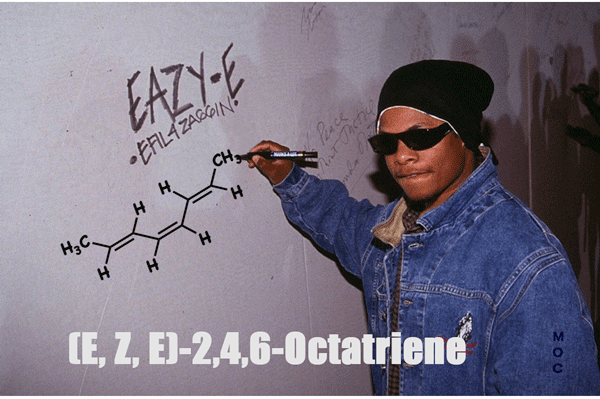
Hi
Could you please explain why can’t we find the Z/E or cis/trans in cyclic alkenes ? Is there any cyclic alkene for which I do precise Z/E or cis/trans ?
In small, cyclic alkenes, the two ring carbons must be on the same side of the alkene (cis) due to ring strain. If you try and make trans-cyclopentene for example you will quickly have a very bent molecular model kit.
The first cyclic alkene with a stable trans- geometric isomer is trans cyclooctene. Once the ring size increases past eight, then geometrical isomerism is possible. So in larger rings we should be specific about whether the double bond is cis or trans (or E/Z).
Hi,
https://pubchem.ncbi.nlm.nih.gov/compound/trans-2-Phenyl-2-butene
Here why is this a trans compound if the two identical methyl groups are on the same side?
It is (E) and also cis. I wonder if this is a glitch with the nomenclature software at pubchem.
No human being would name this “trans”
Greetings…58 years old here, applying to a graduate program, am reviewing my organic chemistry and found your website helpful. Thank you
Glad you find it helpful, Tom. Best wishes on your graduate program. James
Hi James, I have a question want to ask you, does cycloalkene have a geometrical isomer, for cyclohexene or pentene? I think is no, I can’t change the substituent at the double bond to get another isomer, can you tell me am I wrong?
I really want to know.
It’s not energetically possible for 5- or 6- membered rings. Seven membered rings can be trans but have a short lifetime. Only at 8-membered rings do they start to be reasonably stable.
Can you please say which is (cis-trans or E-Z) is accepted in IUPAC nomenclature
E-Z is preferred and is non-ambiguous, but in simple cases cis-trans- will do.
but some molcules
we take the longest chain of carbon to determine if it is cis or trans
rather than take the similar group as a point reference
for example
cis-3,4-Dimethyl-2-pentene
does a cis and E configuration of a molecule make it less polar?
If we’re just talking about alkenes, then yes, very slightly.
Carbon is more electronegative than H. So there is some polarization along the C-H (but not that much).
The boiling point of a molecule is often used as an indicator for how polar it is.
Given this, for which molecule would you expect the boiling point to be higher: cis-2-butene or trans-2-butene? Hint: think about the dipole moments
If a molecule only has one double bond that has EZ stereochemistry do we signify that with either an E or Z without putting a locant in front? Does this idea apply with molecules that have multiple double bonds where only one has EZ stereochemistry?I am curious because I have seen both ways.I have put chemical names into molecule generators online that give the same molecule with or without the locant, so I assume it does not matter.
I do not always set the best example for nomenclature. From a practical standpoint the important thing is that the answer refer to a unique compound. If there is only one double bond capable of E/Z then it is not absolutely necessary to put it in, IMO.
Sometimes E or Z does not need to be mentioned at all. IUPAC gives the example of cyclohexene, where Z is assumed since the E form is extremely unstable.
very well explained, I loved the quiz. Thanks
Can you please explain that part where you said that if we use R/S absolute configuration cis/trans is redundant. My understanding was you need a chiral centre for the RS one and the double bond would be a part of one of the four groups so wouldn’t you still have to say cis this R and cis this S and so on ? And thank you for the efforts you put into this site .
That was in a section on cis trans in *rings*.
In *rings* cis/trans is redundant if there are two chiral centers and you determine R/S on them both.
You said geometric isomers (cis/trans) are a subset of diastereoisomers but aren’t they a subset of stereoisomers instead?
They are a subset of diastereomers, and diastereomers are a subset of stereoisomers.
Can you tell me whether the following compounds have E or Z configuration?
1) CH3 and H on one side of C-C double bond and CHO and Br on the other
2)CH3 and H on one side of C-N double bond and OH on the other
3)CH3 and H on one side of the C-C double bond and Br and OH on the other
Do any of them have identical substituents on one side of the double bond? If not, then they are capable of E/Z configurations.
which is more stable? like which will be the natural product of a reaction? will cis ever form and be more stable than trans?
Which is more stable, cis or trans?
– trans is more stable (less steric hindrance between alkyl groups). I don’t know how to answer the question “which will be the natural product of a reaction” because it depends on multiple factors. In the E2 for example there can be cases where only the cis can form and the trans is not possible due to the requirement that the C-H bond and C-leaving group bond are “anti”.
Cis can form in the reduction of alkynes with Lindlar and H2, for example.
When both cis and trans are possible trans is generally preferred. For example in the elimination (E2) reaction of say, 3-chloropentane, the trans will be the dominant product. I can’t give you an exact proportion at this moment but a good estimate would be at least 4:1.
Can we apply the Z, E nomenclature to orotic acid? What is the Z isomer? How do the rules apply?
Thank you
I had to look up the structure. E and Z descriptors are not required for cycloalkenes with ring sizes less than 8, since the trans- double bond isomers are extremely unstable.
https://en.wikipedia.org/wiki/Orotic_acid
Top notch explanation!!!!
Thank you for the helpful description, but what do we do when we have a RACEMIC substituted-ring that does not have 2 identical substituents. Example a cyclopentane substituted with an amino acid at C1 (2 substituents are amine and carboxcylic acid) and a alkyl sidechanie at C2 (2 substituents are hydrogen and ethyl)?
Thanks,
Michael
From your description the way to do it would be to employ the CIP system and assign R and S configurations to the chiral centers. That will unambiguously assign the configuration of each molecule.
Amazing explanations as always man, you’re a life saver
Glad you find it helpful, DL!
I love the way you explain the concepts. It’s quite hard to find someone teaching organic chemistry in such a simple way. Thank you for creating the materials, these are helpful indeed.
Thank you Kripi!
When a molecule has both a chiral center (R/S) and an alkene functional group (E/Z), which comes first in its name? The R/S before E/Z, other way around, or do we just go by the locant? Thanks!
You just go by the locant. The attached example is (2Z, 7R, 11E)-trideca-2,11-dien-7-ol from the IUPAC Blue book, Page 1190 (P-92.4.2.1). https://imgur.com/XnFQkg7
Is the E/Z protocol appilcable to allene systems?
No it is not. Allenes can have a chiral axis. For chiral allenes, enantiomers are designated by the terms M and P .
So if you have a molecule that is Z konfigurated and another molecule that is E konfigurated, they are diastereomers? What if you have a molecule that is Z konfigurated and the other is Z konfigurated as well? Would they still be diastereomers?
-If the IUPAC descriptor for two molecules is identical except for the fact that they ONLY differ in E and Z then they are diastereomers. e.g. (E)-4-Methyl-3-octene and (Z)-4-Methyl-3-octene.
-If they have different IUPAC names then they are not stereoisomers. (E)-4-Methyl-3-octene and (Z)-4-Methyl-3-nonene
-If the IUPAC name is the same and the E/Z descriptor are the same, they are the same molecule.
Thank you!